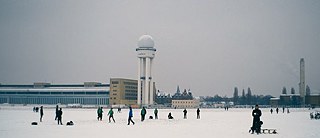MIFF 2018
Central Airport THF: Coming and going

Vast in size but specific in purpose, essential to many but visited fleetingly by most, airports overflow with juxtapositions. But as Karim Aïnouz’s documentary ‘Central Airport THF’ explores, the former Berlin airport now serves vastly different purposes for the two different groups that frequent its grounds.
Airports are a gateway to the world, though only to those in possession of a ticket. They’re also a monument to one of humanity’s greatest achievements — the power of flight — yet they force their transient inhabitants through some of the worst examples of human bureaucracy. To the majority sidling through their doors, they represent the start of a holiday; however even more consider their time time spent inside as a chore. They’re a space where a life less ordinary begins, even if only for a quick trip, but they’re still packed with the usual markers of routine existence, such as cafes, shops, food courts and phone chargers.

And, as Central Airport THF explores, it currently serves vastly different purposes for the two groups that now frequent its grounds. For Berlin residents, the site is an expansive parkland used for cycling, skateboarding, kite-flying, dog-walking, scooting around on segways, jogging and more. For new arrivals to the country — namely those seeking asylum — it has, since 2015, provided a temporary shelter that’s also the only slice of Germany they know.
ZOOMING IN
In Central Airport THF, Brazilian-born, Berlin-based filmmaker Karim Aïnouz (Futuro Beach) captures the many conflicts inherent at Tempelhof Airport, though his isn’t an overt study in contrasts. The director makes the hub’s past and present known with his observational touch, allowing the site’s juxtapositions to arise within his frames. His choices — what to focus on, and when to jump between points of interest — convey much of the movie’s statement, starting with glimpses of a guided walk through the pristine part of the facility that’s still open to tourists. Informative snippets of the tour guide’s commentary set the scene, relaying the necessary background details as well as making plain the beauty of the structure. From there, Aïnouz dedicates the bulk of the documentary’s running time to the more than 2000 people presently forced to call a hangar home, as seen in episodic segments punctuated by the antics of those roam free outside.Two men monopolise the film’s attention: 18-year-old Syrian Ibrahim Al Hussein, who arrived at Tempelhof on his birthday in January 2016, and Iraqi physiotherapist Qutaiba Nafea, who’d like to continue his medical career in his adopted country. It’s the former that is given more screen time — and that gives Central Airport THF its poetic, heartfelt narration — though his is a tale that resonates for both its specificity and universality. As the months pass, providing the documentary with demarcated chapters, Ibrahim waits for the necessary paperwork that will allow him to move on. Around him, vaccinations and hair cuts are announced over the PA system, Christmas sees the brief appearance of decorations and a market, and ping pong helps fill the days. As all of this occurs, Ibrahim recounts his feelings about leaving his family behind, being stranded in his current surroundings and effectively pressing pause on his life to pursue a better future.
FLYING BEYOND
It’s an empathetic approach that Aïnouz takes, appreciating the complicated role that Tempelhof Airport has and still plays in Berlin via a portrait of those who now walk its lengthy expanse. More than that, it’s a methodology that recognises the specific location at the film’s centre, and its specific importance, while also highlighting the human faces of an issue that the space has come to represent in recent years. While documentaries about today’s refugee crisis aren’t lacking, many focus on the scale of the problem and the enormous numbers of displaced asylum seekers, rather than stepping into individual stories. Many, such as Ai Weiwei’s Human Flow — which also features Tempelhof, and is also the product of a foreign-born but Berlin-based filmmaker — do so astonishingly well. However, in honing its focus on a distinctive place but looking beyond its overall function to the tales unravelling within, Central Airport THF has a more intimate air, and evokes an intimately moving response.
Indeed, Central Airport THF always sees its location and subjects for the complex place and people they are, and not the external labels ascribed to them. The documentary proves a contemplative portrait of much that defies easy categorisation, and one that — to borrow an adage — sees both the forest and the trees.